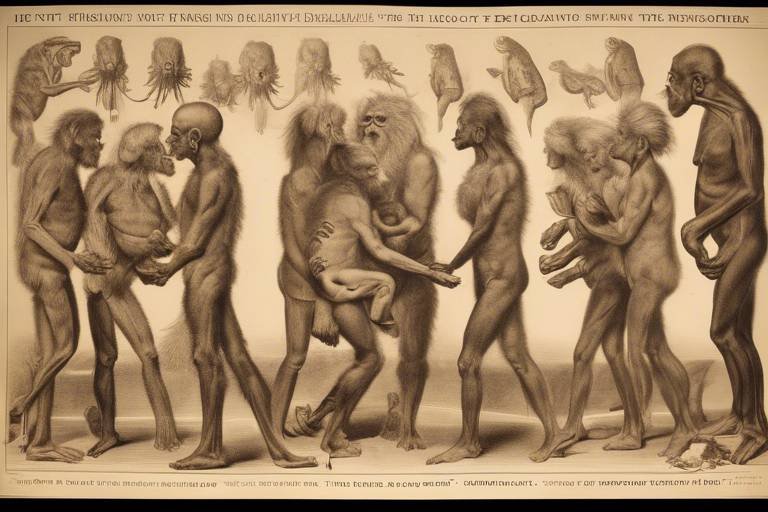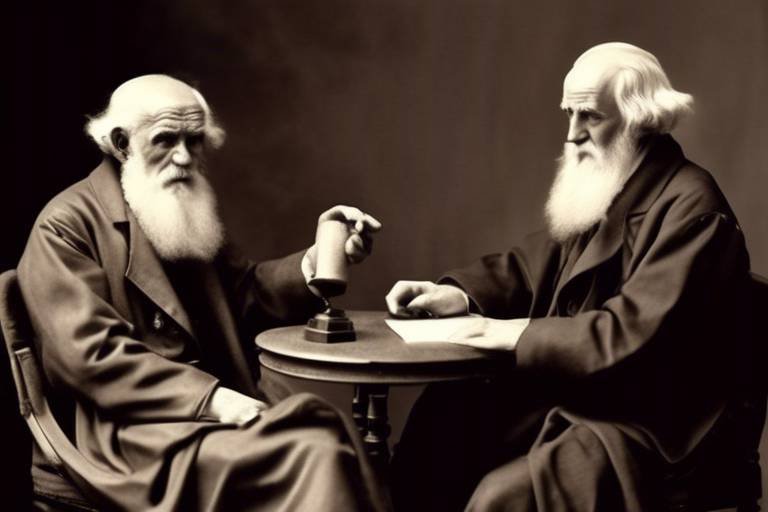Comparing Philosophical and Scientific Understanding of Probability
In our quest to understand the world around us, we often find ourselves grappling with the concept of probability. It’s a term that pops up in various contexts, from gambling to weather forecasts, and even in our daily decision-making. But what does it really mean? The philosophical and scientific perspectives on probability offer us different lenses through which we can interpret uncertainty and chance. Philosophers have long debated the nature of probability, pondering its implications for knowledge and decision-making. On the other hand, scientists apply probability in practical ways, using mathematical models and empirical evidence to navigate uncertainty in their fields. This article delves into these contrasting views, exploring how they shape our understanding of probability and its applications in real life.
Philosophers have approached the concept of probability from various angles, each offering unique insights into how we perceive uncertainty. Historically, probability was often seen as a measure of epistemic uncertainty, reflecting our lack of knowledge about certain events. For instance, the early probabilists like Pascal and Fermat laid the groundwork for understanding probability through games of chance, which highlighted the inherent uncertainty in outcomes. Over time, different interpretations emerged, such as the classical interpretation, which assumes all outcomes are equally likely, and the subjective interpretation, which considers individual beliefs and prior knowledge. These philosophical foundations are crucial as they influence how we make decisions under uncertainty, whether in personal life or in broader societal contexts.
In contrast, the scientific approach to probability is more structured and empirical. Scientists utilize probability to model uncertainty in various disciplines, from physics to economics. The foundation of this approach lies in mathematical models and statistical methods, which allow researchers to quantify uncertainty and make informed predictions. For instance, in the field of medicine, probability plays a vital role in assessing the effectiveness of treatments through clinical trials, where outcomes are analyzed statistically to draw conclusions. The use of empirical evidence to validate models is a hallmark of the scientific method, ensuring that our understanding of probability is grounded in observable reality.
When discussing scientific approaches to probability, two dominant schools of thought emerge: the frequentist and the Bayesian perspectives. Each offers a distinct methodology for interpreting probability, leading to different applications and philosophical implications.
The frequentist interpretation defines probability as the long-run relative frequency of events. In this view, probability is objective, relying on the idea that if an experiment is repeated numerous times, the proportion of times an event occurs will converge to its true probability. This approach emphasizes repeatability and objectivity, making it particularly useful in fields like statistics and quality control. However, it can be limiting as it does not account for prior knowledge or beliefs, which are often crucial in real-world decision-making.
On the other hand, the Bayesian perspective views probability as a measure of belief or certainty. This interpretation allows for a more subjective approach, where prior knowledge and evidence can be incorporated to update beliefs about uncertain events. Bayesian methods are increasingly popular in fields such as machine learning and decision theory, where they provide a flexible framework for dealing with uncertainty. This approach resonates with the idea that our understanding of the world is constantly evolving, shaped by new information and experiences.
The implications of both philosophical and scientific understandings of probability are evident in our everyday lives. From assessing risks in financial investments to making decisions about health and safety, probability shapes our choices. For instance, when we evaluate the likelihood of rain before planning a picnic, we are unconsciously applying both philosophical and scientific principles of probability. The interplay between these perspectives can enhance our decision-making processes, allowing us to navigate uncertainty with greater confidence.
Despite its significance, understanding probability is fraught with complexities and misconceptions. Cognitive biases, such as overconfidence or the tendency to see patterns where none exist, can cloud our judgment and lead to poor decisions. Recognizing these biases is essential for improving our understanding of probability and making more rational choices.
One prevalent misconception is the gambler's fallacy, where individuals believe that past events influence future outcomes in independent events, like coin flips. Another is the misunderstanding of the law of large numbers, which states that as the number of trials increases, the empirical probability will converge to the theoretical probability. These misconceptions can have significant implications for rational thinking and decision-making.
Cognitive biases also play a crucial role in shaping our understanding of probability. For instance, confirmation bias may lead us to favor information that supports our existing beliefs about probability, while ignoring evidence that contradicts them. By being aware of these biases, we can strive to make more informed and rational decisions in uncertain situations.
The relationship between philosophical inquiries and scientific methodologies is not merely a juxtaposition; it’s a dynamic interplay that enriches our understanding of probability. Philosophical questions about the nature of knowledge and belief often arise in response to scientific discoveries, prompting deeper inquiries into what we claim to know about uncertainty.
Scientific advancements in probability theory can challenge or reinforce philosophical perspectives. For example, the rise of Bayesian statistics has prompted philosophers to reconsider the nature of belief and how it interacts with evidence. This dialogue encourages a more nuanced understanding of probability, bridging the gap between abstract thought and practical application.
The potential for interdisciplinary collaboration between philosophy and science is immense. By combining insights from both fields, we can foster a more comprehensive understanding of probability and its applications. This collaboration can lead to innovative approaches to solving complex problems, enhancing our ability to navigate uncertainty in an increasingly complex world.
- What is the difference between frequentist and Bayesian probability? Frequentist probability focuses on long-run frequencies of events, while Bayesian probability incorporates prior beliefs and updates them with new evidence.
- How do cognitive biases affect our understanding of probability? Cognitive biases can distort our perception of probability, leading to flawed judgments and decisions.
- Why is understanding probability important in everyday life? Probability helps us make informed decisions in uncertain situations, from financial investments to health-related choices.

Philosophical Foundations of Probability
The concept of probability has intrigued philosophers for centuries, leading to a rich tapestry of interpretations that shape our understanding of uncertainty and decision-making. At its core, probability is not just a mathematical tool; it is a profound philosophical inquiry into how we perceive the world around us. Philosophers have grappled with questions such as: What does it mean to say something is probable? Is probability an objective feature of the world, or is it merely a reflection of our subjective beliefs? These questions are essential as they influence various fields, from ethics to economics.
Historically, the philosophical approaches to probability can be categorized into several key interpretations, each offering unique insights into the nature of uncertainty. One of the earliest interpretations is the **classical view**, which posits that probability is a ratio of favorable outcomes to the total number of outcomes. This perspective provides a straightforward way to calculate probabilities, especially in games of chance. However, it raises questions about the nature of randomness and whether all outcomes can be equally likely.
Another significant interpretation is the **subjective view**, which argues that probability is a measure of personal belief or degree of confidence in an event's occurrence. This perspective allows for a more flexible understanding of probability, accommodating individual experiences and prior knowledge. For instance, consider a weather forecast predicting rain tomorrow. One person might believe there is a 70% chance of rain based on their past experiences, while another might estimate it at 30% based on their understanding of the current weather patterns. This subjectivity introduces a fascinating complexity to how we make decisions under uncertainty.
Moreover, the **frequentist interpretation** provides a contrasting viewpoint, defining probability as the limit of the relative frequency of an event occurring in a large number of trials. This approach emphasizes the importance of empirical evidence and repeatability, suggesting that probability is an objective property of the world that can be observed and measured. For example, if you flip a coin thousands of times, the probability of landing heads approaches 50%. This interpretation is widely used in statistical methods and scientific research, reinforcing the notion that probability can be quantified and analyzed scientifically.
As we delve deeper into the philosophical foundations of probability, we must also consider how these interpretations influence practical decision-making. In situations laden with uncertainty, individuals often rely on their understanding of probability to assess risks and make informed choices. Whether it’s deciding to invest in a stock, choosing a route during rush hour, or even predicting the outcome of a sporting event, our grasp of probability plays a crucial role. Philosophers argue that a clear understanding of these foundational concepts can lead to better decision-making processes, reducing the impact of biases and misconceptions.
In summary, the philosophical foundations of probability encompass a diverse range of interpretations that challenge us to think critically about uncertainty and belief. By exploring these varying perspectives, we can better appreciate the complexities of probability and its implications in our everyday lives. As we continue this exploration, it becomes evident that the conversation surrounding probability is not just about numbers; it’s about understanding our own perceptions and the world we navigate.

Scientific Approaches to Probability
When we dive into the realm of science, probability takes on a whole new dimension. It's not just a theoretical construct; it's a vital tool that scientists use to understand the complexities of the world around us. Probability helps in making sense of uncertainty, guiding researchers in their quest for knowledge. In scientific disciplines, probability is often utilized through mathematical models, statistical methods, and empirical evidence. These approaches allow scientists to quantify uncertainty and make informed predictions about future events.
Mathematical models serve as the backbone of scientific inquiry, providing frameworks within which hypotheses can be tested. For instance, in fields like physics and economics, models help predict outcomes based on certain variables. Scientists use these models to simulate real-world scenarios, enabling them to analyze potential results without needing to conduct exhaustive experiments. This is particularly useful in fields where experimentation would be impractical or unethical, such as climate science or epidemiology.
Statistical methods are another cornerstone of scientific approaches to probability. They provide the tools necessary for scientists to analyze data, draw conclusions, and validate their findings. Through techniques such as regression analysis, hypothesis testing, and confidence intervals, researchers can assess the likelihood of various outcomes and determine the strength of their evidence. For example, in a clinical trial, statistical methods help researchers evaluate the effectiveness of a new drug by comparing the outcomes of a treatment group to a control group.
Moreover, empirical evidence plays a crucial role in shaping scientific understanding of probability. Scientists gather data through experiments and observations, which they then analyze to identify patterns and trends. This data-driven approach not only enhances the reliability of their findings but also allows for the continuous refinement of probability models. As new data emerges, scientists can adjust their models to better reflect reality, thereby improving their predictive capabilities.
However, it's essential to recognize that the scientific approach to probability is not without its challenges. The interpretation of data can be influenced by various factors, including sample size, data quality, and research bias. Therefore, scientists must remain vigilant and critical of their methodologies to ensure that their conclusions are valid and reliable.
In summary, the scientific approaches to probability are multifaceted, encompassing mathematical modeling, statistical analysis, and empirical research. These methods empower scientists to navigate uncertainty and make informed decisions based on evidence. As we continue to explore the intricacies of probability, it's clear that a robust understanding of these scientific principles is essential for driving innovation and discovery across various fields.
- What is the importance of probability in scientific research?
Probability helps quantify uncertainty, allowing scientists to make informed predictions and decisions based on empirical data. - How do mathematical models contribute to scientific understanding?
Mathematical models provide frameworks for testing hypotheses and simulating real-world scenarios, enhancing predictive capabilities. - What are common statistical methods used in scientific studies?
Common methods include regression analysis, hypothesis testing, and confidence intervals, all of which help analyze data and draw conclusions. - Why is empirical evidence crucial in probability?
Empirical evidence allows scientists to validate their models and refine their understanding based on real-world data.

Frequentist vs. Bayesian Perspectives
The debate between the Frequentist and Bayesian perspectives on probability is one of the most fascinating discussions in the realm of statistics and philosophy. At its core, this debate revolves around how we interpret the concept of probability and its application in real-world scenarios. Frequentists view probability as a long-run relative frequency of events, which means they focus on the outcomes of experiments conducted a large number of times. This perspective emphasizes the idea of objectivity and repeatability. For example, if you flip a coin many times, the probability of landing heads is determined by the proportion of heads observed in those flips over time.
On the other hand, Bayesians interpret probability as a measure of belief or certainty. This approach allows for a more subjective interpretation of probability, where prior knowledge and experience can influence the assessment of uncertainty. In this framework, if you were to flip that same coin, your belief about the probability of it landing heads can be updated based on new evidence or data, such as the outcomes of previous flips. This leads to a dynamic understanding of probability, where beliefs are continuously revised as more information becomes available.
To illustrate the differences between these two approaches, consider the following table:
| Aspect | Frequentist Perspective | Bayesian Perspective |
|---|---|---|
| Definition of Probability | Long-run frequency of events | Degree of belief or certainty |
| Data Interpretation | Objective, based on repeated trials | Subjective, incorporates prior knowledge |
| Updating Beliefs | Static, based on fixed probabilities | Dynamic, beliefs are updated with new evidence |
| Application Example | Estimating the probability of a die roll based on many rolls | Adjusting the probability of rain based on weather forecasts and past experiences |
This fundamental difference in understanding probability has profound implications for how we analyze data and make predictions. For instance, in fields such as machine learning and artificial intelligence, the Bayesian approach has gained popularity due to its flexibility in updating predictions as new data becomes available. Meanwhile, the Frequentist approach is often favored in traditional statistical methods, where the focus is on hypothesis testing and confidence intervals.
Ultimately, both perspectives offer valuable insights and tools for understanding uncertainty. The choice between Frequentist and Bayesian methods often depends on the context of the problem at hand, the nature of the data, and the specific objectives of the analysis. As we navigate through the complexities of probability, it becomes clear that each perspective has its strengths and weaknesses, and a comprehensive understanding of probability may require integrating elements from both schools of thought.
- What is the main difference between Frequentist and Bayesian probability?
Frequentist probability focuses on the long-run frequency of events, while Bayesian probability emphasizes subjective belief and updates based on new evidence. - Can I use both perspectives in my analysis?
Yes, many analysts integrate both Frequentist and Bayesian methods to leverage the strengths of each approach. - Which approach is more widely used in scientific research?
Frequentist methods have traditionally been more common in scientific research, but Bayesian methods are gaining traction due to their flexibility.

Frequentist Interpretation
The Frequentist interpretation of probability is a cornerstone of statistical theory, emphasizing a clear and objective approach to understanding chance. At its core, this perspective defines probability as the long-run relative frequency of an event occurring based on repeated trials. Imagine flipping a coin; the Frequentist would argue that if you flip it a large number of times, the proportion of heads will converge to 0.5. This approach is rooted in empirical observation, where the essence of probability is derived from actual data collected through experiments.
One of the most appealing aspects of the Frequentist interpretation is its reliance on reproducibility and objectivity. In a Frequentist framework, the focus is on the outcomes of random experiments and the laws governing them. This method allows researchers to make predictions based on the frequency of past events, which can be particularly useful in fields such as medicine, engineering, and economics. For example, when conducting clinical trials, Frequentists analyze the effectiveness of a new drug by examining the proportion of patients who respond positively compared to those who do not, providing a clear statistical basis for decision-making.
However, the Frequentist approach does have its limitations. Critics argue that it fails to account for prior knowledge or subjective beliefs, which can be crucial in many real-world situations. For instance, if a scientist has previous data suggesting a particular outcome is likely, the Frequentist model does not incorporate that information. This leads to a more rigid interpretation of probability that can sometimes overlook the nuances of uncertainty.
To illustrate the differences, consider the following table that compares the Frequentist and Bayesian interpretations:
| Aspect | Frequentist Interpretation | Bayesian Interpretation |
|---|---|---|
| Definition of Probability | Long-run frequency of events | Degree of belief or certainty |
| Incorporation of Prior Knowledge | No | Yes |
| Focus | Objective outcomes from experiments | Subjective interpretation and updates |
| Examples | Clinical trials, quality control | Predicting weather, updating beliefs |
In summary, while the Frequentist interpretation provides a robust framework for understanding probability through experimentation and objective measures, it is essential to recognize its limitations. As we navigate the complexities of uncertainty, it becomes increasingly important to consider alternative perspectives, such as the Bayesian interpretation, which offers a more flexible approach. This interplay between different interpretations of probability not only enriches our understanding but also enhances our decision-making processes in an uncertain world.
- What is the main difference between Frequentist and Bayesian interpretations of probability?
The main difference lies in how they define probability. Frequentists see it as the long-run frequency of events, while Bayesians view it as a measure of belief or certainty. - Why do some scientists prefer the Frequentist approach?
Many scientists prefer the Frequentist approach because it emphasizes objectivity and reproducibility, relying on data collected from experiments without incorporating subjective beliefs. - Can both interpretations be used together?
Yes, many researchers find value in integrating both perspectives to gain a more comprehensive understanding of probability and uncertainty.

Bayesian Interpretation
The of probability offers a unique lens through which to view uncertainty. Unlike the frequentist approach that relies heavily on long-run frequencies of events, Bayesian probability is grounded in subjective belief. This means that probability is not just a number; it reflects an individual's degree of certainty about an event occurring based on prior knowledge or evidence. Imagine you’re a detective piecing together clues. Each clue you gather adjusts your belief about who the culprit might be. This is the essence of Bayesian thinking—updating our beliefs as new information becomes available.
At the heart of Bayesian probability is Bayes' theorem, a mathematical formula that describes how to update the probability of a hypothesis as more evidence becomes available. It’s like having a mental toolbox that allows you to refine your understanding of the world. The formula is expressed as:
P(H|E) (P(E|H) * P(H)) / P(E)
In this equation:
- P(H|E) is the probability of the hypothesis H given the evidence E.
- P(E|H) is the probability of observing the evidence E given that H is true.
- P(H) is the initial probability of the hypothesis before considering the evidence.
- P(E) is the overall probability of the evidence.
This framework allows individuals to incorporate their prior beliefs and adjust them as they gather new evidence. For instance, if you’re trying to determine whether it will rain tomorrow, your prior belief might be informed by the weather forecast. As the day progresses and you see dark clouds forming, your belief in the likelihood of rain increases. This adaptability makes the Bayesian approach particularly powerful in dynamic situations where information is constantly evolving.
However, it’s important to note that Bayesian probability is not without its criticisms. Some argue that because it relies on subjective beliefs, it can lead to inconsistencies and biases. For example, two people might assess the same situation and arrive at drastically different probabilities based solely on their prior knowledge and experiences. This subjectivity can sometimes make it challenging to reach a consensus in fields that require objective analysis, such as science or law.
Despite these challenges, the Bayesian interpretation has found a home in various domains, from machine learning to medical diagnosis. In these fields, the ability to update probabilities with new data is not just useful; it’s essential. For instance, in medical diagnostics, a doctor might start with a certain probability of a disease based on a patient’s symptoms. As test results come in, they can adjust their probability assessments accordingly, leading to better-informed treatment decisions.
In conclusion, the Bayesian interpretation of probability invites us to embrace uncertainty with a flexible mindset. It encourages us to view probability as a living, breathing concept that evolves with our understanding of the world. By continuously updating our beliefs in light of new evidence, we not only improve our decision-making processes but also gain deeper insights into the nature of knowledge itself.

Applications in Real Life
Probability isn't just a dry mathematical concept locked away in textbooks; it permeates our daily lives in ways that are both profound and practical. From the moment you flip a coin to decide who gets the last slice of pizza to complex algorithms predicting the stock market's next move, probability shapes our decisions and actions. It's like a hidden thread weaving through the fabric of everyday choices, guiding us through uncertainty with a semblance of clarity.
In the realm of healthcare, probability plays a crucial role in determining treatment plans and assessing risks. For instance, medical professionals often rely on statistical probabilities to evaluate the effectiveness of a new medication. Clinical trials utilize probability models to predict outcomes, helping doctors make informed decisions about patient care. Imagine a doctor explaining the likelihood of recovery based on various treatment options; this is probability in action, ensuring that decisions are backed by data rather than mere intuition.
In the business world, probability is a fundamental tool for risk assessment and strategic planning. Companies use probability to forecast sales, analyze market trends, and even evaluate the chances of a new product's success. For example, a marketing team might analyze consumer behavior data to estimate the probability of a successful campaign, allowing them to allocate resources effectively. This application of probability helps businesses minimize risks and maximize returns, akin to a tightly calculated game of chess where every move counts.
Moreover, in the field of sports, probability is utilized extensively to enhance performance and strategy. Coaches and analysts use statistical models to assess player performance, predict game outcomes, and even determine the best strategies against opponents. Think about it: when a basketball coach decides to go for a three-pointer in the final seconds of a game, they're not just relying on gut feeling; they're weighing the probabilities of success based on past performance and situational factors. This analytical approach transforms the game into a calculated dance of chance and skill.
Even in everyday decision-making, we subconsciously apply probability without realizing it. Whether it's deciding whether to carry an umbrella based on the chance of rain or choosing a restaurant based on reviews, we constantly evaluate probabilities. This mental calculus helps us navigate the complexities of life, making choices that align with our goals and preferences. The next time you find yourself weighing options, remember that you're engaging in a probabilistic assessment, even if it's just a casual dinner choice.
To illustrate the diverse applications of probability, consider the following table that highlights various fields and how they utilize probability:
| Field | Application of Probability |
|---|---|
| Healthcare | Risk assessment for treatments and clinical trials |
| Business | Market analysis and forecasting |
| Sports | Performance analysis and game strategy |
| Everyday Life | Decision-making in uncertain situations |
In summary, the applications of probability are vast and varied, influencing decisions across multiple domains. Whether it's in making critical healthcare choices, strategizing in business, analyzing sports performance, or navigating daily life, probability serves as a guiding force. Understanding these applications not only enhances our comprehension of probability but also empowers us to make more informed decisions in an unpredictable world.
- What is probability? Probability is the measure of the likelihood that an event will occur, expressed as a number between 0 and 1.
- How is probability used in everyday life? We use probability to make decisions based on uncertain outcomes, such as whether to carry an umbrella or invest in a stock.
- What are the two main interpretations of probability? The two main interpretations are the frequentist interpretation, which focuses on long-run frequencies, and the Bayesian interpretation, which incorporates prior beliefs and evidence.
- Why is understanding probability important? Understanding probability helps us make better decisions in uncertain situations, reducing the impact of cognitive biases and misconceptions.

Challenges in Understanding Probability
Understanding probability can often feel like trying to catch smoke with your bare hands—elusive and frustrating. One of the biggest challenges lies in the **complexities** of the concept itself. Probability is not merely about numbers; it intertwines with our perceptions, beliefs, and decision-making processes. Many people find themselves grappling with the abstract nature of probability, leading to **misconceptions** that can skew their understanding and influence their choices.
One notable challenge is the presence of **cognitive biases**. These biases can distort our perception of probability and lead us to make irrational decisions. For instance, the **gambler's fallacy**, which is the belief that past random events can influence future outcomes, often leads individuals to make poor bets based on faulty reasoning. Imagine a coin toss: just because the coin has landed on heads five times in a row, it does not increase the likelihood of tails coming up next. Yet, many people feel compelled to bet on tails, believing it is "due." This illustrates how our intuition can mislead us when it comes to understanding probability.
Another significant misconception is related to the **law of large numbers**. This law states that as the number of trials increases, the average of the results will converge on the expected value. However, many interpret this to mean that short-term results will reflect long-term probabilities. This misunderstanding can lead to disappointment or surprise when outcomes deviate from what is expected in the short run. For example, if a student takes a test and scores poorly, they might assume that they will always score poorly, ignoring the fact that with more practice and experience, their average score will likely improve over time.
To further illustrate these challenges, consider the following table that outlines common misconceptions and their implications:
| Misconception | Explanation | Implications |
|---|---|---|
| Gambler's Fallacy | Believing past events affect future probabilities. | Leads to poor betting decisions. |
| Law of Large Numbers | Assuming short-term results reflect long-term probabilities. | Can cause disappointment and misjudgment of skills. |
| Overconfidence Bias | Underestimating the role of chance in outcomes. | Results in risky decisions and poor planning. |
Moreover, the **impact of these misunderstandings** extends beyond personal decisions. In fields like finance, healthcare, and policy-making, flawed interpretations of probability can lead to significant consequences. For example, a healthcare provider misjudging the probability of a disease could result in inadequate treatment plans for patients. Similarly, policymakers relying on incorrect probability assessments could make misguided decisions that affect entire communities.
In conclusion, the challenges in understanding probability are multifaceted, stemming from cognitive biases, misconceptions, and the inherent complexity of the concept. To navigate these challenges, it is crucial to foster a deeper awareness of how probability works and to question our intuitions. By doing so, we can make more informed decisions and better understand the world around us.
- What is probability? Probability is a measure of the likelihood that an event will occur, expressed as a number between 0 and 1.
- How do cognitive biases affect our understanding of probability? Cognitive biases can distort our perception of probability, leading to irrational decisions and misunderstandings.
- What is the difference between frequentist and Bayesian probability? Frequentist probability focuses on long-run frequencies of events, while Bayesian probability incorporates prior knowledge and beliefs into the analysis.
- Why is understanding probability important? A solid grasp of probability helps individuals make better decisions in uncertain situations, from personal finance to health care.

Common Misconceptions
When it comes to understanding probability, many people fall prey to a variety of misconceptions that can skew their perception of chance and risk. These misunderstandings can lead to poor decision-making, especially in situations involving uncertainty. One of the most notorious fallacies is the gambler's fallacy, which is the belief that past random events can influence future outcomes. For example, if a coin lands on heads several times in a row, one might think that tails is "due" to happen next. This kind of thinking ignores the fundamental principle that each flip is independent, and the probability remains 50/50 each time.
Another common misconception is related to the law of large numbers. Many assume that if they observe a small sample, it will accurately reflect the expected probabilities. However, the law of large numbers states that as the size of the sample increases, the sample mean will get closer to the expected value. This means that small samples can lead to significant deviations from expected probabilities. For instance, if you flip a coin just ten times, you might get seven heads and three tails, leading you to think that the coin is biased. But as you increase the number of flips to a thousand, the ratio will likely approach 50/50, demonstrating the law's power.
Understanding these misconceptions is crucial for rational thinking. When faced with uncertainty, it's important to rely on statistical reasoning rather than intuition alone. Many people also struggle with the concept of conditional probability, which can lead to incorrect conclusions. For example, the famous Monty Hall problem illustrates how intuition can mislead us: if you're given a choice between three doors, behind one of which is a car, and after you pick one, the host opens another door revealing a goat, the probability of winning the car by switching doors is actually 2/3, not 1/2 as many would instinctively believe.
These misconceptions not only affect personal decisions but also have broader implications in fields like finance, healthcare, and public policy. For instance, a misunderstanding of risk can lead to poor investment choices or misallocation of resources in healthcare. To combat these issues, education on probability and statistics is essential. By fostering a better understanding of these concepts, we can improve decision-making processes and reduce the impact of cognitive biases.
In summary, recognizing and addressing common misconceptions about probability can significantly enhance our ability to navigate uncertainty. Whether it's understanding the independence of random events or grasping the implications of large sample sizes, a clearer view of probability can empower individuals to make more informed decisions.
- What is the gambler's fallacy? The gambler's fallacy is the mistaken belief that past random events can influence the likelihood of future outcomes.
- How does the law of large numbers work? The law of large numbers states that as the size of a sample increases, the sample mean will get closer to the expected value.
- Can you explain the Monty Hall problem? The Monty Hall problem is a probability puzzle that demonstrates how switching choices can increase the chances of winning.

Cognitive Biases in Probability
Cognitive biases play a significant role in how we understand and interpret probability, often leading us astray in our decision-making processes. These biases are systematic patterns of deviation from norm or rationality in judgment, and they can significantly distort our perception of risk and uncertainty. For instance, consider the availability heuristic: this bias causes individuals to overestimate the likelihood of events based on how easily examples come to mind. If a person frequently hears about airplane accidents in the news, they might irrationally conclude that flying is more dangerous than it statistically is. This is a classic case of how our brains can mislead us when it comes to assessing probabilities.
Another common bias is the anchoring effect, where individuals rely too heavily on the first piece of information they encounter when making decisions. For example, if someone is told that a particular stock has a 70% chance of increasing in value, they might anchor their expectations to that figure, ignoring subsequent data that suggests a lower probability. This can result in poor investment choices and a misunderstanding of the actual risk involved.
Moreover, the gambler's fallacy illustrates how biases can lead to flawed reasoning about probability. This fallacy occurs when individuals believe that past random events can influence future outcomes. A gambler might think that after flipping heads several times in a row, tails is "due" to happen, which is a misunderstanding of independent events. Such misconceptions can have real-world implications, affecting not just individual choices but also broader societal behaviors, such as gambling habits and risk-taking in uncertain scenarios.
To further illustrate these biases, we can look at a table summarizing some of the most common cognitive biases related to probability:
| Bias | Description | Example |
|---|---|---|
| Availability Heuristic | Overestimating the likelihood of events based on how easily they come to mind. | Believing plane crashes are common after hearing about one in the news. |
| Anchoring Effect | Relying too heavily on the first piece of information encountered. | Fixating on an initial stock price as a basis for future expectations. |
| Gambler's Fallacy | Believing that past random events affect future outcomes. | Thinking that tails is more likely after flipping heads multiple times. |
Understanding these biases is crucial for improving our decision-making skills. By recognizing how they distort our perception of probability, we can take steps to mitigate their effects. For instance, training ourselves to analyze situations more objectively, seeking out diverse perspectives, and relying on statistical data rather than gut feelings can help us make more informed choices. Ultimately, being aware of cognitive biases empowers us to navigate uncertainty with greater clarity and confidence.
- What are cognitive biases? Cognitive biases are systematic patterns of deviation from norm or rationality in judgment, affecting our decision-making processes.
- How do cognitive biases affect probability judgments? They can lead to misinterpretations of risk and uncertainty, causing individuals to make irrational decisions based on flawed reasoning.
- Can cognitive biases be mitigated? Yes, by increasing awareness of these biases, analyzing situations objectively, and relying on statistical data, individuals can improve their decision-making skills.

The Intersection of Philosophy and Science
When we dive into the realms of philosophy and science, it’s like exploring two sides of the same coin. Both disciplines seek to understand the world around us, yet they approach the concept of probability from different angles. Philosophy asks the "why" behind uncertainty, while science focuses on the "how" to measure and predict it. This intersection is not just a meeting point; it’s a vibrant dialogue that enriches our understanding of probability and its implications.
Philosophical inquiries often challenge scientific methodologies, questioning the assumptions that underpin statistical models and empirical evidence. For instance, when scientists use probability to predict outcomes, philosophers might ask about the nature of belief and knowledge that such predictions are based upon. This critical examination can lead to profound insights, prompting scientists to refine their models and consider the implications of their findings more deeply.
Moreover, scientific discoveries can, in turn, influence philosophical thought. As new theories in probability emerge—such as those arising from quantum mechanics or advancements in artificial intelligence—they can either reinforce or challenge existing philosophical perspectives. This reciprocal relationship is essential for both fields, as it encourages a more nuanced understanding of probability that encompasses both objective measurements and subjective interpretations.
To illustrate this interplay, consider the following table that summarizes the key differences and connections between philosophical and scientific approaches to probability:
| Aspect | Philosophical Approach | Scientific Approach |
|---|---|---|
| Focus | Understanding the nature of belief and knowledge | Measuring and predicting outcomes through data |
| Methodology | Critical analysis and logical reasoning | Statistical models and empirical evidence |
| Key Questions | What does it mean to know something? | How can we accurately predict outcomes? |
| Implications | Influences ethical and decision-making frameworks | Shapes technological advancements and practical applications |
This collaborative approach between philosophy and science not only enhances our understanding of probability but also opens up new avenues for research and application. For example, interdisciplinary studies that combine philosophical inquiry with scientific experimentation can yield innovative solutions to complex problems, such as those found in fields like economics, healthcare, and environmental science.
In conclusion, the intersection of philosophy and science is a dynamic space where ideas collide and evolve. By embracing both perspectives, we can cultivate a richer understanding of probability that informs our decision-making and enhances our grasp of uncertainty in an increasingly complex world.
- How do philosophy and science differ in their approach to probability? Philosophy focuses on the conceptual and ethical implications of probability, while science emphasizes empirical measurement and prediction.
- Can philosophical insights improve scientific practices? Absolutely! Philosophical inquiry can challenge assumptions and lead to more robust scientific methodologies.
- What are some real-world applications of the intersection of philosophy and science? Fields such as economics, healthcare, and environmental science benefit greatly from integrating philosophical and scientific perspectives on probability.

Philosophical Implications of Scientific Discoveries
The intersection of philosophy and science is a fascinating realm, especially when it comes to understanding probability. As scientific discoveries unfold, they often challenge or reinforce philosophical perspectives, leading to profound implications about the nature of knowledge, belief, and reality. For instance, when scientists uncover new statistical models or experimental results, these findings can prompt philosophers to reevaluate their definitions of probability and uncertainty. This dynamic relationship can be likened to a dance, where each partner influences the other's movements, creating a more intricate and nuanced understanding of the world.
One significant implication of scientific discoveries is the shift in how we view certainty and knowledge. Traditionally, philosophers have grappled with the concept of knowledge as justified true belief. However, with the advent of Bayesian probability, which emphasizes the role of prior beliefs and subjective interpretation, the conversation has evolved. This raises questions such as: Can we truly claim to "know" something if our beliefs are based on probabilities rather than absolutes? This philosophical inquiry encourages a deeper exploration into the foundations of epistemology—how we come to know what we know.
Moreover, scientific advancements often lead to the emergence of new philosophical questions. Take, for example, the development of quantum mechanics. The probabilistic nature of quantum events has challenged deterministic views, suggesting that at a fundamental level, reality may be inherently uncertain. This has led philosophers to ponder the implications of indeterminacy, asking whether our understanding of causality and predictability needs to be fundamentally revised. Such discussions can spark debates about free will, moral responsibility, and the very fabric of reality.
Furthermore, the collaboration between scientific and philosophical thought can illuminate practical applications of probability. For instance, in fields like medicine and economics, understanding the probabilistic nature of outcomes can lead to better decision-making frameworks. Philosophers can contribute by exploring the ethical implications of these decisions, such as the moral responsibilities of scientists in communicating uncertainty or the societal impacts of probabilistic models in public policy.
In conclusion, the philosophical implications of scientific discoveries regarding probability are vast and complex. They encourage us to question our assumptions about knowledge, certainty, and reality. As we continue to explore these intersections, we not only enrich our understanding of probability but also deepen our appreciation for the intricate tapestry of human thought. By embracing both philosophical inquiry and scientific rigor, we can navigate the uncertainties of life with a more informed and thoughtful perspective.
- What is the relationship between philosophy and science?
Philosophy questions the foundational principles and implications of scientific discoveries, while science provides empirical evidence that can support or challenge philosophical theories. - How does probability relate to decision-making?
Probability helps quantify uncertainty, allowing individuals and organizations to make informed decisions based on the likelihood of various outcomes. - What are the implications of quantum mechanics on our understanding of reality?
Quantum mechanics introduces a probabilistic framework that challenges classical deterministic views, leading to philosophical debates about the nature of reality and causality. - Can philosophical perspectives influence scientific research?
Yes, philosophical inquiries can shape the questions scientists ask and the interpretations of their findings, fostering a deeper understanding of the implications of their work.

Collaborative Approaches
When we think about the intersection of philosophy and science, it’s like imagining two sides of a coin—each distinct yet inseparable. Both domains, while pursuing different paths, can come together to create a richer understanding of probability. This collaboration is not just beneficial; it’s essential in navigating the complexities of uncertainty in our world. By merging philosophical inquiry with scientific rigor, we can tackle some of the most pressing questions about probability and its implications.
One of the most intriguing aspects of this collaboration is how philosophical questions can shape scientific research. For instance, when scientists grapple with the implications of their findings, they often find themselves asking philosophical questions about the nature of reality, causality, and knowledge. These inquiries can lead to the formulation of new hypotheses and experimental designs that are more robust and comprehensive. In turn, scientific discoveries can inform philosophical debates, challenging long-held beliefs and prompting a reevaluation of what we consider to be knowledge. This dynamic interplay is crucial for both fields.
Consider a few key areas where philosophy and science might collaborate effectively:
- Ethics of Probability: The ethical implications of probability in fields like medicine and finance can lead to philosophical discussions about risk, fairness, and decision-making.
- Foundational Questions: Philosophers can provide insights into the foundational concepts of probability, helping scientists to refine their models and assumptions.
- Interdisciplinary Research: Collaborative research projects that include both philosophers and scientists can yield innovative approaches to understanding complex systems, such as climate change or economic behavior.
Moreover, the development of interdisciplinary programs in universities is a promising step forward. These programs encourage students to explore the philosophical underpinnings of scientific methods, fostering a deeper appreciation for both fields. Imagine a classroom where students dissect the implications of statistical models while simultaneously pondering the philosophical questions they raise. This kind of environment not only cultivates critical thinking but also prepares future leaders to approach real-world problems with a multifaceted perspective.
In conclusion, the collaborative approaches between philosophy and science in the realm of probability are not just about merging ideas; they are about creating a dialogue that enhances our understanding of uncertainty. By recognizing the value each discipline brings to the table, we can foster a culture of inquiry that embraces complexity and encourages innovative solutions to the challenges we face. Whether it’s through ethical considerations, foundational discussions, or interdisciplinary research, the potential for growth and discovery is immense.
Q1: How do philosophy and science differ in their approach to probability?
A1: Philosophy often explores the conceptual and ethical implications of probability, while science focuses on empirical data and mathematical models to assess uncertainty.
Q2: Can you give an example of how philosophy has influenced scientific research?
A2: Philosophical questions about causality have led to more rigorous experimental designs in fields like psychology and medicine, where understanding the relationship between variables is crucial.
Q3: Why is it important to study probability from both philosophical and scientific perspectives?
A3: Studying probability from both perspectives allows for a more comprehensive understanding of uncertainty, leading to better decision-making and more effective solutions in various fields.
Frequently Asked Questions
- What is the philosophical interpretation of probability?
The philosophical interpretation of probability delves into the nature of uncertainty and belief. Philosophers have explored various frameworks, such as the subjective interpretation, which views probability as a measure of personal belief, and the objective interpretation, which treats it as a property of the physical world. This exploration helps us understand how we make decisions under uncertainty and the implications of those decisions.
- How do scientists use probability in their work?
Scientists utilize probability to model uncertainty, analyze data, and make predictions. By applying statistical methods, they can assess the likelihood of various outcomes based on empirical evidence. This approach is crucial in fields like medicine, economics, and environmental science, where understanding risk and variability can lead to better decision-making and improved outcomes.
- What is the difference between frequentist and Bayesian probability?
The main difference lies in their interpretations of probability. Frequentists define probability as the long-run frequency of events occurring in repeated trials, focusing on objective measures. In contrast, Bayesians view probability as a degree of belief or certainty, allowing for personal interpretation and the incorporation of prior knowledge. This fundamental distinction influences how data is analyzed and how predictions are made across various disciplines.
- Can you explain common misconceptions about probability?
Absolutely! One common misconception is the gambler's fallacy, which suggests that past events affect future outcomes in independent trials, like flipping a coin. Another is the misunderstanding of the law of large numbers, where people believe that small samples will reflect the expected probability, which isn't always the case. These misconceptions can lead to flawed decision-making and irrational behavior in uncertain situations.
- How do cognitive biases influence our understanding of probability?
Cognitive biases can skew our perception of probability, leading us to make irrational decisions. For instance, confirmation bias may cause us to favor information that supports our beliefs while ignoring contradictory evidence. This misinterpretation of probability can have significant consequences, especially in critical areas like finance and healthcare, where accurate risk assessment is vital.
- What is the relationship between philosophy and science in understanding probability?
The relationship is quite symbiotic! Philosophy provides a framework for questioning and interpreting the principles underlying probability, while science offers empirical data and methodologies to test these philosophical claims. Together, they enhance our understanding of probability, encouraging interdisciplinary collaboration that can lead to more comprehensive insights and applications.
- How do scientific discoveries impact philosophical views on probability?
Scientific discoveries often challenge or reinforce philosophical views by providing new evidence or perspectives on probability. For example, advancements in statistical methods may prompt philosophers to reevaluate their theories on uncertainty and belief. This ongoing dialogue between philosophy and science fosters deeper inquiries into the nature of knowledge and helps refine our understanding of probability.



















